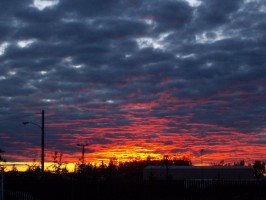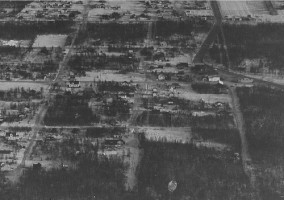Peeling back layers of living in Anchorage
by Tracy Kalytiak |
Take a quick look at Wikipedia and you'll see Anchorage emerged 100 years ago as a railroad tent city at Ship Creek, and sprawled into a municipality encompassing 300,000 people, nearly 2,000 square miles and 95 different languages.

A new UAA project aims to capture the essence of Anchorage neighborhoods, via tours, stories and photos. This vista was seen on an August evening, from Mountain View. Photo by Tracy Kalytiak
What the Wiki doesn't convey is a sense of the city's soul, its neighborhoods-where those people eat, sleep, walk, study, celebrate, mourn and worship-and the layers of lives those homes, streets, schools, churches and businesses have held in the span of a century.
Taking a guided walk through these neighborhoods, a UAA faculty member says, illuminates their past, opens minds to new experiences in the present and stimulates ideas of what they could become in the future. Her goal? Creating an Anchorage Community Atlas that records the cultural richness and diversity found where people live.
"When I moved here two years ago, I was surprised that the most prominent map is the one you see downtown in restaurants," said Bree Kessler, term assistant professor at UAA's Department of Health Sciences and faculty fellow with the UAA Center for Community Engagement and Learning. "But that's not participatory; it's aimed at tourists. I'm interested in the social life of small urban spaces. People are good at exploring wilderness, but the city's untouched. People don't spend a day exploring Mountain View-it's easier to go into the mountains. There are special places for people here."
Delving into different worlds
Kessler recently launched a project that will take people on walks or bike rides through Mountain View, Government Hill, Fairview, Spenard, Sand Lake and other neighborhoods and help people learn more resonant, personal reminiscences about those places from men and women who lived there. The two-hour walks are scheduled for 10 a.m.-noon on the following dates:
• July 19, walk, Fairview • Aug. 16, bike, Mountain View • Aug. 23, walk, Spenard • Sept. 13, walk, Government Hill
Twenty spots are available for each tour. Register at www.uaa.alaska.edu/engage; children are welcome to attend, with parental discretion for their walking/biking ability in a group. Those who can't attend the free tours may contribute to the project by using #MyAnchorageIs to describe their Anchorage. People with questions may contact Kessler at bckessler@uaa.alaska.edu.
Dr. Clare Dannenberg of UAA's English department and Dr. Judith Owens-Manley, director of the CCEL, are collaborating with Kessler. Owens-Manley organizes the superstructure of the project while Dannenberg and three UAA students are recording oral histories taken from neighborhood residents and plan to collect photos and other memorabilia. Graduate students Brianna Bym and September Reynaga, and undergraduate student Sarah Carter are conducting the interviews.
"We're letting the people who live there drive it," Dannenberg said. "It's such a fresh perspective, this component of letting people speak, express their own take on the historical derivation of the neighborhood. It's a multitextual experience. It's so amazing how all our interests have converged-we each have unique pieces that feed into each other."
So far, the women have used a "friend-of-a-friend" technique to find and interview people in Fairview, for the Anchorage Centennial Project. They hope to extend funding from a grant the project received from Anchorage Centennial Celebration, Alaska Humanities Forum and Rasmuson Foundation so they can glean stories and images from people living in other Anchorage neighborhoods.
"We'd love to go to Airport Heights, Hillside, Rabbit Creek, Turnagain," Dannenberg said. "I can see expanding into the Muni[cipality]. We can't do it in one summer. I'm looking at a five-year space where I can get in to interview layers and layers of people. So far we've had two participants per interview, 24 folks in one month. We're looking to get 200 folks."
The interviewers don't follow a carved-in-stone list of questions.
"We touch on subjects, like, tell me what it was like to grow up here," Dannenberg said. "Some might be ghost stories, stories about school, just getting to know people and how they know their community. Part of what we intend is also to have people who want to write down their stories. All of those pieces together can enrich an atlas like Bree has in mind."
'It's not about what hour it is'
One of her favorite questions, Dannenberg says, is asking how people ended up in Anchorage.
"Everybody's story is so particular to them, so meaningful, especially those who stay," she said. "Anchorage is such a unique space. It looks very transient on the surface, but it's also an anchoring space. People become anchored to the space quickly and it becomes who they are. It's a special living circumstance in Alaska, not like you see in the Lower 48."
Dannenberg says she finds incredible the sense of wilderness within Anchorage's urban landscape.
"The type of folks it draws in to stay, time becomes different," she said. "You don't think of time in the same way. It's not about what hour it is, it's about light, the seasons-the type of winter it is, breakup. The way people tell their stories in relaxed, natural conversation gives insight into how they live in community here."
Interested in language and identity, Dannenberg moved from Virginia to a neighborhood near Kincaid Park two years ago. She's worked on similar sociolinguistic projects in Appalachia and first talked with Owens-Manley about the neighborhood walk project early this year.
"Since then, it's been like a freight train coming through-unstoppable," she said.
Anchorage is completely different from the areas in Virginia and eastern Tennessee where Dannenberg lived before.
"I love the multicultural environment, with so many languages and nationalities represented here," she said. "It's not about the architecture-it doesn't have the brick, stature and age of the East Coast and South that I'm used to-but you don't need to pay attention to architecture when you look up and around you. I'm drawn to the openness of landscape and the friendliness here."
Clark Yerrington feels a deep connection with his Mountain View neighborhood, which he first discovered in the 1970s and moved into 15 years ago.

The Anchorage neighborhood of Mountain View, as it appeared in a 1953 aerial photo. Photo courtesy of Clark Yerrington
"A couple of coworkers at the time lived there and my mom and stepfather had an income property there in the pipeline era," said Yerrington, who writes the Mt. View Forum blog. "It suits my personality and outlook. [I'm] a longtime fan of out-of-the-mainstream and marginalized culture and a desire to root for the underdog led me to try the 'urban pioneer' life."
Mountain View staggers under a reputation of being rife with drugs and crime, a place of poverty and lives knocked askew. But Yerrington says there's so much more that's good about the neighborhood, aspects that might not be as readily apparent.
"It is, in fact, unique in the USA as a neighborhood where people of many ethnic backgrounds are distributed without pattern, along with the presence of WASPs like myself," he said. "This just can't help but lead one into some very unique encounters and exposures."
What would surprise most people about Mountain View?
"Bears, moose, fox and all the other Alaska animals in the woods surrounding the neighborhood," Yerrington said. "Bike-route connectivity in three directions. Full-service grocery with a surprising amount of unique ethnic food. A lot more quiet and pleasant than its reputation would prepare one for. An admirable resiliency, in the face of complex human issues."
This story written by Tracy Kalytiak, UAA Office of University Advancement.
 "Peeling back layers of living in Anchorage" is licensed under a Creative Commons Attribution-NonCommercial 4.0 International License.
"Peeling back layers of living in Anchorage" is licensed under a Creative Commons Attribution-NonCommercial 4.0 International License.














